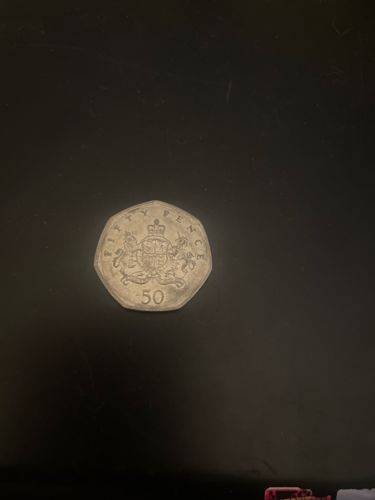Fifty Pence (50p)
Country of Origin: United Kingdom
Year of Issue: Based on the design (Royal Arms), this coin was issued between 1969 and 2008. Without seeing the obverse (which would typically show the monarch's effigy and the definitive year), an exact year cannot be determined from this image alone.
Denomination: Fifty Pence (0.50 GBP)
Composition: Cupro-nickel (75% copper, 25% nickel)

Brief Description
The coin is a heptagonal (seven-sided) fifty pence piece. The visible side (likely the reverse) features the Royal Arms of the United Kingdom, specifically the Shield of the Royal Arms, which is Quartered: 1st and 4th, three lions passant guardant (England); 2nd, a lion rampant within a double tressure flory-counter-flory (Scotland); 3rd, a harp (Ireland). The shield is surmounted by a crown (St Edward's Crown, representing the monarch). Below the shield, the denomination '50' is clearly visible, with 'FIFTY PENCE' written above the design.
Historical Significance
The fifty pence coin was first introduced in 1969 as part of the decimalisation of British currency, replacing the 10 shilling note. Its distinctive heptagonal shape made it easily identifiable. The Royal Arms design was a standard reverse for the 50p from 1969 until 2008 when a new series of designs depicting parts of the Royal Shield was introduced. This coin represents a significant period in British monetary history as the country transitioned from the pre-decimal system to the decimal system.
Estimated Value
For common circulation issues, the estimated value is typically face value (€0.50 - €1.00 GBP) for circulated coins. Uncirculated or proof examples, or those with specific commemorative designs, could be worth more, ranging from a few pounds to tens or even hundreds for rare variants.
Care Instructions
To properly care for this coin, handle it by the edges to avoid transferring oils from your skin, which can cause tarnishing. Store it in a cool, dry place, ideally in a non-PVC coin flip, slab, or album. Do not clean the coin, as cleaning can devalue it by damaging its original surface and patina.
Created At: 2025-07-13T00:39:42.293210